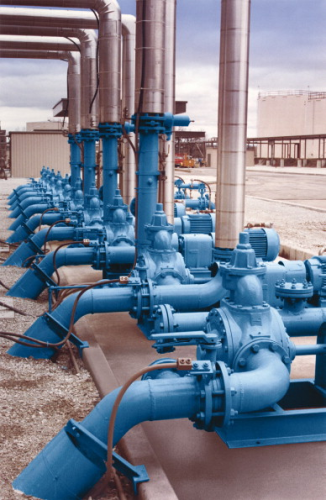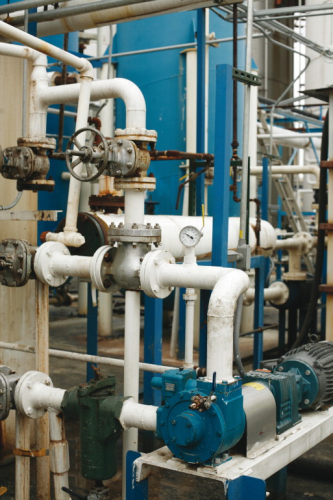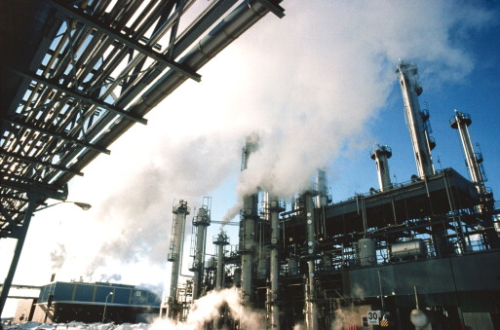


When President Bush signed the Energy Policy Act of 2005, the country's first comprehensive new energy policy since 1992, into law, most of the attention it received focused on the provisions that addressed the future supply and makeup of the country's motor-fuel pool. Transportation fuel was a hot-button topic at the time (and remains so today) as gasoline and diesel prices continued to creep upward, while tough questions were being asked regarding from where future supply would come. But while the Energy Policy Act, or EPAct, did include landmark provisions that set thresholds for the production and use of biofuels and other forms of alternative and renewable energy in the future, in reality, EPAct 2005 was about much, much more than fueling the nation's fleet of vehicles.
The major tenets of EPAct 2005, in addition to promoting alternative and renewable energy sources, are to encourage energy efficiency and conservation, reduce dependence on foreign sources of energy, increase domestic energy production, modernize the electricity grid, and encourage the expansion of nuclear energy.
Included in EPAct 2005 is much verbiage regarding the production, conservation and more efficient use of all types of energy in all settings, from private residences to commercial buildings to manufacturing and industrial plants. In general, EPAct sets new minimum energy-efficiency standards for a wide range of consumer and commercial products and encourages the sale and production of these products, which will help increase the supply of available energy in the future.
The problem
According to the United States Department of Energy's Office of Energy Efficiency and Renewable Energy (EERE), the industrial sector consumes 33.6% of all of the energy used in this country. That's more than the transportation (27.9%), residential (21.1%) and commercial (17.4%) sectors use. In that 33.6% of all energy used, US industry represents 29% of the country's electricity demand and 37% of its natural-gas demand. And, depending on which report you read, pumping systems—which are the second most widely used machines in the world after motors—account for anywhere between 27% and 33% of the total electricity used in the industrial sector.
Pumps are widely used to transfer fluids for processing applications, move water and wastewater, provide fluid circulation in cooling systems and furnish the motive force in hydraulic systems. All manufacturing plants, commercial buildings and municipalities rely on pumping systems for their daily operations.
So, with this amount of energy use centered, in general, in the industrial sector and, in particular, on pumping systems inefficiencies in their operation have the capability to exacerbate any energy crunch the nation might be feeling. And there are inefficiencies. According to the Hydraulic Institute they are:
- Energy efficiency is peripheral to most corporate business strategies
-
Research and development expenditures are minimal for process and energy technologies
-
Incentives are lacking to encourage investment in energy-efficient technologies
-
No common standard exists for making energy
-
Workplace energy-management skills are insufficient
-
Energy supply is constrained due to limited energy fuel choices and volatile energy prices
-
Future environmental regulations are uncertain.
These inefficiencies exist because, while the cost of energy is closely monitored and managed at the plant level, the actual use of energy may not be due to facility managers being more concerned with production reliability than the expense of energy efficiency. A disconnect also exists between the budgets for equipment purchases and operations, meaning that equipment purchases can often result in energy-inefficient procurement practices.
The solution
While energy inefficiency in the industrial sector is a major concern, there is a silver lining – and there has to be.
In the 1990s, the Department of Energy set forth a number of Industrial Energy Efficiency Programs. Phase 1 of these programs was to develop transformation techniques designed to encourage industrial energy efficiency. Phase 2, which covered the years 2000-2005, was to focus on the deployment of these new techniques through the use of industry-specific publications, system experts and other training tools. The final phase of integration and sustainability was to begin in 2006 with a series of energy-efficiency assessments of the largest manufacturing plants in the country with the goal of developing market-based, sustainable industrial energy management.
However, when EPAct 2005 came into being, the goals of these Industrial Energy Efficiency Programs were ratcheted up. Beginning in 2007, with a targeted completion date of 2017, the new vision for the industrial sector was to improve ‘energy intensity’ 2.5% per year, or a total of 25% between now and 2017.
That's where the silver lining comes in. According to the Department of Energy's publication, ‘US Industrial Motor Systems Market Opportunities Assessment,’ pump systems offer the largest opportunity for energy-efficiency improvements in industry. In fact, case studies have shown that better system design and a more effective application of pumps can save 20% or more in energy costs. In addition to saving money and energy, better system design and more effective pump applications would also reduce maintenance costs while increasing productivity.
With that in mind, there are many different ways to save energy in pumping systems. Some opportunities are shown in Table 1.
Achieving these goals, however, will require a modification in the thinking of many plant and facility managers. Too often, they view their facilities from the perspective of the individual pump or component. They also tend to promote the practice of sizing pumps conservatively to ensure that the needs of the system will be met under all conditions, while often overlooking the added cost of oversizing pumps. This practice leads to higher-than-necessary system operating and maintenance costs, since oversized pumps also typically require more frequent maintenance. Even though centrifugal pumps are the most widely used pump technology in the world, an often-overlooked consideration is to use a different technology such as positive displacement pumps.
In order for operations to significantly improve their energy savings, they must change their thinking and take a systems approach, shifting the focus from the performance of these individual components to that of the entire system. This approach will enable operators to improve the reliability, performance and efficiency of their overall pumping systems, resulting in not only greater energy savings, but also higher productivity and optimized performance and profitability. Again utilizing suggestions offered by the Hydraulic Institute, a systems approach involves the following types of interrelated actions:
- Establish current conditions and operating parameters
-
Determine present and estimate future process-production needs
-
Gather and analyze operating data and develop load-duty cycles
-
Assess alternative system designs and improvements
-
Determine the most technically and economically sound options, taking into consideration all of the subsystems
-
Implement the best option
-
Assess energy consumption with respect to performance
-
Continue to monitor and optimize the system
-
Continue to operate and maintain the system for peak performance
In other words, to use a systems approach effectively, a pumping system designer needs to understand system fundamentals, know where opportunities for improvements are commonly found and have a list of key resources that can help to identify and implement successful projects.
To aid the operator in creating a systems approach at the plant level, a number of key energy programs have emerged over the past couple of years. Here's a closer look at three of them.
Save Energy Now
A component of the Department of Energy's Industrial Technologies Program (ITP), Save Energy Now, helps industrial plants operate more efficiently and profitably by identifying the ways to reduce energy use in key process systems. One of the key components of the Save Energy Now programme is the implementation of energy assessments at manufacturing facilities across the nation. These assessments help manufacturing facilities identify immediate opportunities to save energy and money. The assessment can also be used as part of an overall energy management strategy at the plant that will continue to yield bottom-line benefits for the company.
Beginning in 2005, the operations of 200 of the nation's top energy-intensive industrial facilities were reviewed by DOE-qualified ‘Energy Experts’ who used DOE software tools and technical information to target a specific system area. By the end of 2006, energy-efficiency assessments had been completed for plants in 18 industrial groups in a total of 41 states and Puerto Rico. These 200 assessments recommended improvements that would annually save US$2.5 million in energy costs per plant that, on average, equaled 10% of the assessed plant's energy costs. Based on six-month follow-up interviews with 179 of the assessed plants, about 7% of the total number of energy-saving recommendations had been implemented with another 64% of the recommendations either in progress, planned, under review or awaiting funds for implementation. However, in just six months, these 179 assessed plants had implemented measures for energy cost savings totaling US$30.4 million per year.
For small and medium-sized plants, assessments are conducted by a series of 26 Industrial Assessment Centers (IAC) located at 31 universities nationwide. Utilizing teams of engineering faculty and students, the assessment begins with a university-based IAC team conducting a survey of the eligible plant, followed by a one- or two-day visit to the facility where engineering measurements are taken as a basis for assessment recommendations. The team then performs a detailed analysis for specific recommendations with related estimates of costs, performance and payback times. The assessments primarily focus on energy-intensive systems: process heating, steam, compressed air, fans and pumps. Within 60 days, a confidential report detailing the analysis, findings and recommendations of the team is sent to the plant. In two to six months, follow-up phone calls are placed to the plant manager to verify that the recommendations will be implemented.
With the success of the 2006 assessments, the DOE had identified a further 250 plants for energy assessments in 2007. As of July 1, 2008, a total of 570 assessments have been completed bringing the total identified energy cost savings to more than US$807 million with more than US$117 million energy savings already implemented to date.
Pump Systems Matter
A program developed by the Hydraulic Institute called ‘Pump Systems Matter’ is focused on the energy savings, efficiency and economics of pumps and pumping systems. This focus aims to lower the energy needs of North America while improving the bottom-line profitability of businesses by offering pump users strategic, broad-based energy management and performance optimization solutions, mainly centered around centrifugal pump technologies. To do this, the Hydraulic Institute has a number of informational areas on its Pump Systems Matter Web site (www.pumpsystemsmatter.org/) that have been designed to be an educational resource for getting started on optimizing pumping systems.
One of the key elements of the Pump Systems Matter program is the Pump System Improvement Modeling Tool (PSIM). PSIM is a free educational tool that has been formulated to help users better comprehend the hydraulic behavior of pumping systems. PSIM enables users to calculate the pressure drop and flow distribution in straight-path, simple branching or looped pumping systems. PSIM calculates pump energy usage and energy cost over time by using Net Present Value concepts. PSIM is also capable of creating pump vs. system curves, a powerful tool that helps engineers better understand the intricacies of pump/system behavior.
Smart Energy Program
Developed by Blackmer, the Smart Energy Program emphasizes the ability of its positive displacement sliding-vane and eccentric-disc lines of pumps to improve the energy efficiency of plants where pump systems are in operation. Designed to be energy efficient themselves, the use of Blackmer pumps, by extension, will also positively affect plant operations where energy efficiency is a consideration in pump selection.
Since there is no one-pump-fits-all solution, particular attention to proper pump selection will become increasingly important, not only to deliver productivity gains but to also control energy consumption. With this in mind, by virtue of their inherent energy and mechanically-efficient designs, positive displacement sliding vane and eccentric disc pump technologies are well suited to offer manufacturers immediate, high-value advantages and solutions in fulfilling their energy-saving initiatives.
Although the operating principles of positive displacement and centrifugal pumps differ widely, both types of pumps can be used to serve many of the same applications. In these instances, certain positive displacement pumps may offer substantial opportunities in the effort to improve processes and productivity as well as maintenance and energy cost savings. Positive displacement pumps generally require less motive energy than centrifugal pumps, and they offer more flexibility relative to dealing with changes in pressure and flow requirements in continuous-type processes. Also, positive displacement pumps, sliding vane and eccentric disc technologies in particular, maintain higher efficiencies throughout the viscosity range. Therefore, in the overlap where both types of pumps can operate, a positive displacement pump's high mechanical efficiency can offer improved energy efficiency. Further, over time the internal clearances in centrifugal pumps, as in positive displacement gear and lobe pumps, will increase resulting in decreased efficiency.
Sliding vane positive displacement pumps, however, utilize self-adjusting vanes that eliminate clearance increase issues thereby maintaining near original hydraulic efficiencies even after extended service life. Eccentric disc pumps also self adjust internal pumping clearances via their inherent design. The ability of sliding vane and eccentric disc positive displacement pumps to offer and maintain higher efficiency levels than other pump technologies can mean substantial energy savings for the user.
Blackmer has developed its blackOPS® Web-based tool that allows users, distributors and original equipment manufacturers to properly size pump equipment. By providing the correct pump data and curves, users can select the ideal pump that will not only perform properly, but also maximize system efficiency.
Additional details regarding the energy efficiencies of sliding vane and eccentric disc pump technologies are available by contacting Blackmer.
The bottom line
While improving the energy efficiency of every manufacturing plant is the ultimate goal of all of these programmes, as well as EPAct 2005, reaching the goal of 25% industrial energy intensity improvement by 2017 will take a cooperative effort amongst all involved in the manufacturing sector.
As President Bush said back in August 2005, “The bill I sign today is a critical first step. It's a first step toward a more affordable and reliable energy future for American citizens. Most of the serious problems … have developed over decades. This bill is not going to solve our energy challenges overnight. It's going to take years of focused effort to alleviate those problems.”
|
Contact Tom Stone Director of Marketing Blackmer 1809 Century Avenue SW, Grand Rapids, MI 49503-1530 USA Tel: +1 616-241-1611 Fax: +1 616-241-3752 |






